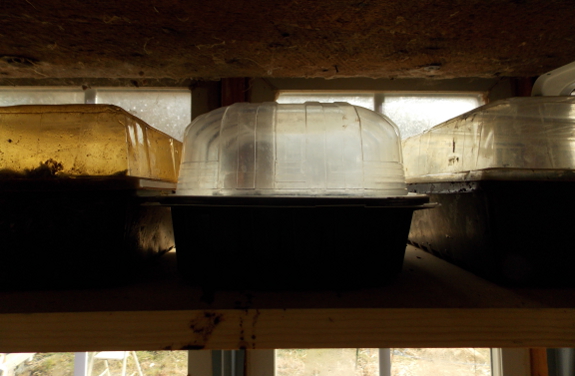
Dealing with damping off
 Last spring, I had trouble for the first time with damping off.
This fungal disease is evident when seemingly healthy seedlings die
near where their stems meet the ground. When you're itching for
the first seedlings of the year to push forth their greenery, damping
off can be very traumatic for the gardener. (Okay, maybe that's
just me.)
Last spring, I had trouble for the first time with damping off.
This fungal disease is evident when seemingly healthy seedlings die
near where their stems meet the ground. When you're itching for
the first seedlings of the year to push forth their greenery, damping
off can be very traumatic for the gardener. (Okay, maybe that's
just me.)
Since I was using the same stump dirt
as in previous years, I felt that the issue last year might have been
problematic fungi colonizing my old seed-starting flats. Sure, I
could have bought new flats, but I thought it would be easier (and
definitely cheaper) to simply soak the ones I have in bleach water for
about half an hour. After that, I filled up the flats and seeded
my onions, then made a control flat out of a rotisserie-chicken
container. (Rotisserie chickens seldom come home with us, but we
had a long day in the big city last week and I was too exhausted to
cook, so Mark bought one as a rare treat.)

Hopefully I won't see any
damping off at all, but if I see it in the store-bought flats but not
in the chicken flat, I'll know I was right about the flats being the
problem (and wrong about the bleach water curing it). On the other
hand, if I see damping off in all the flats, I'll know the stump dirt
is the problem and will have to consider one of the mainstream cures ---
either buying real potting soil or sterilizing my stump dirt in the
oven. I like to think the bacteria and fungi in my unsterilized
potting soil are good for baby seedlings, but I could be wrong.
Other possible ways to
deal with damping off include tweaking the environment and using
home-made sprays. The fungi involved like cool, damp conditions,
so if you can warm things up (maybe with a heating pad under the flats)
and keep watering to a minimum, you might be able to whip the bad
microorganisms even if they're present. Some gardeners even make
chamomile or garlic tea and pour it over their potting soil to protect
the seedlings. I'll let you know if I have to resort to any of
those extremes, and if so, which ones work. In the meantime, feel
free to chime in about your battles with damping off in the comments.
Want more in-depth information? Browse through our books.
Or explore more posts by date or by subject.
About us: Anna Hess and Mark Hamilton spent over a decade living self-sufficiently in the mountains of Virginia before moving north to start over from scratch in the foothills of Ohio. They've experimented with permaculture, no-till gardening, trailersteading, home-based microbusinesses and much more, writing about their adventures in both blogs and books.
Want to be notified when new comments are posted on this page? Click on the RSS button after you add a comment to subscribe to the comment feed, or simply check the box beside "email replies to me" while writing your comment.

Hi All,
One of my local farmer friends sterilize his compost in a steel bucket on the top of his wood stove. He adds a gallon of water. He pokes a compost thermometer into the bucket and waits until it reads 150F throughout.
He is one of the most successful farmers I know. Doesn't get in line for gov. handouts, runs multiple hoop houses bought with his own dollars.
Kinda like you (Anna and Mark)! Pretty exceptional guy.
So I would try heating some of your starter soil to "kill bad stuff" to see if that 'cures' the problem.
I seem to recall that you don't want to get it too hot? I can't remember why?
warm regards, John